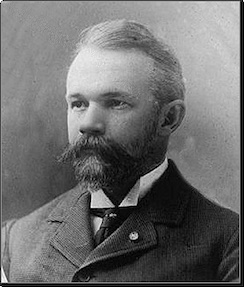
Sport: Shooting
Born: March 27, 1855
Died: September 6, 1927
Town: Jersey City, New Jersey
William A. Libbey III was born March 27, 1855 in Jersey City, NJ. His parents, William Jr. and Elizabeth, provided him with all the advantages in life, thanks to a thriving family business. Serious, strong and coordinated, he excelled in a wide range of gentlemen’s sports at Princeton University, including target shooting. For a rowing competition in Saratoga, William asked his father to buy 1,000 yards of orange and black ribbon to stretch along the shoreline. These colors would later become the official colors of Princeton.
After graduating in 1877, William convinced his father to finance a scientific expedition to Colorado. The West was still quite wild at this time—General Custer had met his demise at Little Big Horn just one year earlier. The 18 students were issued military-style uniforms and maintained military discipline throughout. As they traveled through rowdy mining towns, the group had to endure taunts and laughs. During the expedition, William became the first person to climb 14,000-foot Mt. Princeton. After traveling to Europe, William accepted a faculty position at his alma mater, where he became a popular geography professor.
William’s proficiency with firearms and his leadership qualities earned him the rank of colonel in the National Guard. In 1912, despite being in his late-50s, he was named to the U.S. Olympic team. At that time, there were more than a dozen marksmanship events in the Summer Games. In 1912, he teamed with William Leuschner, William McDonnell and Walter Winans to win a silver medal in the Running Deer Single Shot competition—an event that involved shooting at a moving deer-shaped target. At 57, William ranks among the oldest medal-winners in Olympic history.
In 1912, medals were also given for artistic champions. Winans won a gold medal in the sculpture competition.
In 1920, William participated in his second Olympics, this time as an andjutant to the US shooting team. He also served briefly as the president of the NRA.
William Libbey continued to teach into the 1920s. He died in Princeton at age 72 in 1927. Ever the adventurer, during his time at Princeton, he accompanied Robert Peary on two of his Arctic expeditions and had an Alaskan glacier named after him. William’s pioneering oceanography work also led to the naming of the Libbey Deep (off the coast of New England) in his honor.